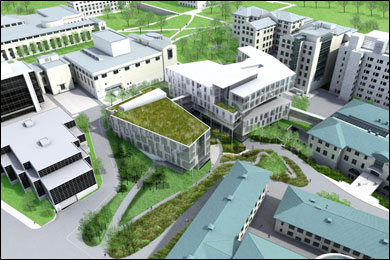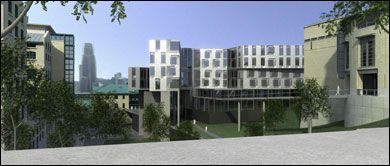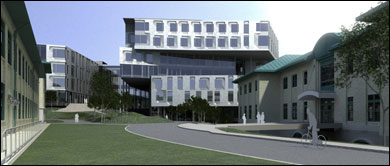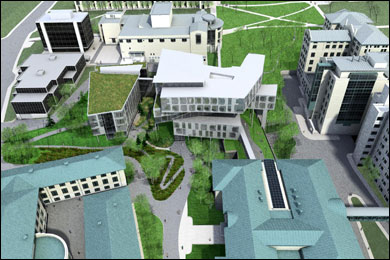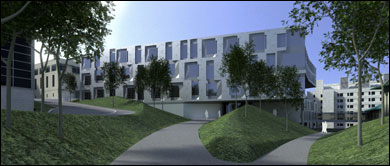|
|
||||
|
|
University Unveils Plans for New Gates Center for Computer Science
Above is an aerial rendering as seen from Forbes Avenue of the new Gates Center for Computer Science (middle). The two structures will sit on a 5.6-acre site on the West Campus and will include 318 offices as well as labs, computer clusters, lecture halls, classrooms and a 250-seat auditorium. (Click on these images to download high-resoultion versions.)
You could call it a "Tale of Two Buildings."
Initial designs for the new Gates Center for Computer Science were recently introduced to the university community, revealing not one but two contemporary structures that will make up the new home for the School of Computer Science (SCS).
Mack Scogin, principal of the Atlanta-based Mack Scogin Merrill Elam Architects Inc., gave a preview of plans for the new center during a School of Architecture-sponsored lecture at the Carnegie Museum Lecture Hall and at an information session for the campus community in McConomy Auditorium. The center was also discussed during a session at the School of Computer Science's 50th anniversary celebration.
The new structures will sit on a 5.6-acre site on the university's West Campus, surrounded by Cyert Hall, the Purnell Center for the Arts, Doherty Hall, Newell-Simon Hall, Smith and Hamburg halls and the Collaborative Innovation Center. University officials will seek silver LEED certification from the U.S. Green Building Council for the new facility.
The buildings will be organized around an outdoor winter garden and connected by a four-story lobby containing pedestrian walkways between the upper floors. Their 209,000 square feet will contain 318 offices as well as labs, computer clusters, lecture halls, classrooms and a 250-seat auditorium. Fifty percent of the center will be devoted to office space, with labs (18%), common areas (15%), classrooms (13%) and planetary robotics (4%) making up the other half.
The Gates Center as seen from the Cut. The exterior, or skin, of the structure is still in question, however, architect Mack Scogin proposes that the building's exterior be 52% solid zinc or slate and 48% glass windows.
The smaller of the two buildings, about 50,000 square feet, will be dedicated to research. This four-story structure, shaped like a trapezoid, will face Forbes Avenue between Cyert and Hamburg halls. A glass-enclosed entry lobby with pedestrian bridges will connect to the larger multi-faceted, six-story companion building.
Other design features and amenities include several common or "collaborative" areas; a building form that takes advantage of the variety of views to and from the site; the generous use of glass to bring natural light to all of the individual offices and collective spaces; "green roofs" to abate storm water runoff; efficient building systems and controls; sustainable materials; a central ADA accessible rampway through the building connecting the Cut to the West Campus; and an underground parking garage for 150 vehicles.
Pedestrian pathways, benches, trees, shrubbery and the landscaping design of Michael Van Valkenburgh Associates will help to create a West Campus Quadrangle. Van Valkenburgh developed the landscape design for the Kraus Campo atop the Posner Center.
Computer Science Professor Guy Blelloch, chair of the SCS building committee, said the architect's designs and proposals have far exceeded expectations. "We are delighted with the design thus far. All offices will have natural light and there are many open collaborative neighborhood spaces. We're extremely impressed with how well the architects have responded to the university's needs," he said.
A view of the Gates Center from in front of the Collaborative Innovation Center.
Scogin spoke about the design challenges his firm faced as a result of the university's goals for the center. He noted the difficulty in trying to connect the building to the Cut, some 80 feet above the lowest point on the West Campus site. He said one of the most important instructions they received was to make the building private but still open to the campus community.
"The first three levels of the Gates Center welcome users of the building and members of the campus community. This is a very public space, the most public part of the building," said Scogin noting the elliptical rampway, computer cluster, café and main lobby area.
While the structure's interior design received praise from Blelloch, the proposed exterior, or "skin," of the buildings has raised some eyebrows. Scogin's designs show that the Gates Center will look nothing like the traditional yellow brick buildings on campus.
"The university has said to us that this is a different time," said Scogin who repeatedly expressed his admiration for Henry Hornbostel, the architect who designed the university's original buildings. "Hornbostel would say, 'This is the 21st Century, use the tools of the time.'"
"Early on in our preliminary planning meetings it was suggested that it was time to move beyond 'the yellow brick road.' The challenges of the site presented an opportunity to move in a new direction," said Ralph Horgan, vice provost for Campus Design and Facility Development.
An aerial view from the Collaborative Innovation Center.
Scogin proposes that the building's exterior would be 52% solid zinc or slate and 48% glass windows. Window sizes and placements vary in the current design.
Several individuals at the information session raised questions about the interior and exterior design of the structures. Concerns included the building's skin and gray color, its windows and its sustainability.
"We will work to address everyone's concerns," Scogin said. "We're doing our best to listen. We've made a lot of adjustments thus far and will continue to do so. We're always looking for alternatives. We never go down one track," he said.
The Gates Center for Computer Science was made possible by a $20 million lead gift from the Bill and Melinda Gates Foundation. Hard construction costs for the structures are projected to be $64 million according to Horgan. He estimates $24 million in soft costs, such as architecture and engineering fees, asbestos abatement, demolition, utility relocations, furniture, wireless instructional technology and other amenities, for a total price of $88 million.
The Gates Center from Forbes Avenue.
Demolition Before Construction; Parking Impacted
Before Gates Center construction can begin, four existing campus structures must be razed: the Planetary Robotics Building, the Campus Printing and Publications Building, the Row Garages and the Old Student Center.
Demolition of the Planetary Robotics Building is scheduled to begin Monday, April 24. The Campus Printing and Publications Building and Row Garages will be taken down between May 1 and June 1, and the Old Student Center will be demolished between June 1 and August 1. Work to relocate existing utilities will take place beginning in June.
The demolition projects will impact 163 campus parking spaces. Permit holders in affected lots will be offered alternative campus parking.
A Closer Look at Mack Scogin Merrill Elam
Mack Scogin Merrill Elam Architects, named for the two principals, Mack Scogin and Merrill Elam, has earned more than 50 national and regional awards of excellence from the American Institute of Architects.
Based in Atlanta, the firm has designed many academic buildings on college and university campuses across the country, including Arizona State, Berkeley, Clemson, Emory, Ohio State, Tulane and Wellesley. Their design of The Knowlton School of Architecture at The Ohio State University was the subject of a feature story in Architecture Record magazine in May 2005.
Scogin is the Kajima Adjunct Professor of Architecture at the Harvard Graduate School of Design. He was chairman of the Department of Architecture at Harvard from 1990 to 1995. Scogin earned his bachelor's degree in architecture from Georgia Tech in 1966.
Elam received her degree in architecture from Georgia Tech in 1971 and earned an MBA from Georgia State in 1982. Her teaching experience includes assignments at the University of Toronto, Texas, Yale, Rice, Harvard and the University of Illinois at Chicago.
For more on the firm, visit http://www.msmearch.com/msmearch.html
For more on the new Gates Center, visit http://gatescenter.blog.cs.cmu.edu/.
Bruce Gerson |
||
|
Carnegie Mellon Home |
||||
